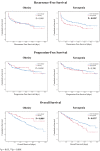Body composition as a predictor of oncological outcome in patients with non-muscle-invasive bladder cancer receiving intravesical instillation after transurethral resection of bladder tumor
- PMID: 37637042
- PMCID: PMC10448957
- DOI: 10.3389/fonc.2023.1180888
Body composition as a predictor of oncological outcome in patients with non-muscle-invasive bladder cancer receiving intravesical instillation after transurethral resection of bladder tumor
Abstract
Introduction: Body status, categorized as sarcopenia or obesity and assessed using body mass index and body composition, affects the outcome of bladder cancer patients. However, studies comparing disease progression, recurrence, or overall survival in patients with non-muscle-invasive bladder cancer (NMIBC) with different body compositions are lacking. Therefore, we conducted a retrospective study to identify the impact of body composition, sarcopenia, and obesity on the oncological prognosis of patients with NMIBC who underwent transurethral resection of bladder tumor (TURBT) with Bacillus Calmette-Guerin (BCG) intravesical instillation (IVI).
Methods: Patients with NMIBC who had undergone TURBT with adjuvant IVI with BCG from March 2005 to April 2021 were included. Body composition parameters were evaluated using computed tomography images of the third lumbar vertebrae and further categorized by sarcopenia and obesity. Oncological outcomes including recurrence-free survival (RFS), progression-free survival, and overall survival (OS) after treatment were analyzed.
Results: A total of 269 patients were enrolled. Subcutaneous adipose tissue (SAT) density was a significant predictor of RFS, whereas psoas muscle density was a significant predictor of OS in the multivariate analysis. Patients with sarcopenia but without obesity tolerated significantly fewer BCG IVIs than patients without sarcopenia or obesity. Patients with sarcopenia had poorer RFS and OS than those without sarcopenia. In contrast, patients with obesity had better OS than those without obesity.
Discussion: Body composition parameters, including SAT density and psoas muscle density, emerged as significant predictors of OS and RFS, respectively. Hence, our findings indicate that body composition is a helpful measurement to assess the oncological outcomes of patients with NMIBC.
Keywords: bladder cancer; body composition; intravesical instillation; non-muscle-invasive bladder cancer; obesity; sarcopenia; transurethral resection.
Copyright © 2023 Huang, Lin, Chuang, Chuang, Pang, Wu, Chang, Yu, Lin, Kan, Chu, Hung, Hsieh and Shao.
Conflict of interest statement
The authors declare that the research was conducted in the absence of any commercial or financial relationships that could be construed as a potential conflict of interest.
Figures


References
-
- Cambier S, Sylvester RJ, Collette L, Gontero P, Brausi MA, van Andel G, et al. . EORTC nomograms and risk groups for predicting recurrence, progression, and disease-specific and overall survival in non-muscle-invasive stage Ta-T1 urothelial bladder cancer patients treated with 1–3 years of maintenance Bacillus Calmette-Guerin. Eur Urol (2016) 69:60–9. doi: 10.1016/j.eururo.2015.06.045 - DOI - PubMed
-
- Sylvester RJ, van der Meijden AP, Oosterlinck W, Witjes JA, Bouffioux C, Denis L, et al. . Predicting recurrence and progression in individual patients with stage Ta T1 bladder cancer using EORTC risk tables: a combined analysis of 2596 patients from seven EORTC trials. Eur Urol (2006) 49:466–5; discussion 475. doi: 10.1016/j.eururo.2005.12.031 - DOI - PubMed
LinkOut - more resources
Full Text Sources
Research Materials
Miscellaneous

